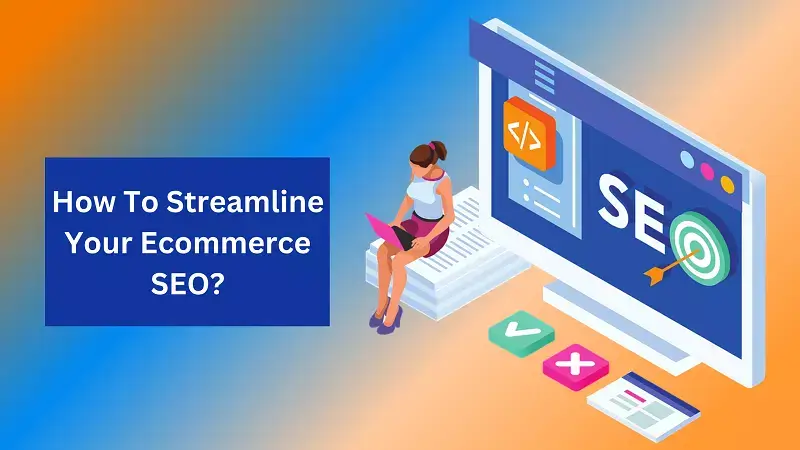How To Streamline Your Ecommerce SEO?
What is eCommerce SEO?
Ecommerce SEO (Search Engine Optimization) is optimizing an online store to improve its visibility in search engine results pages (SERPs) and drive more organic traffic to the site. This is done through a combination of on-page and off-page optimization techniques, such as conducting keyword research, optimizing product pages, improving website performance, and building high-quality inbound links. The goal of an eCommerce development agency is to increase the quantity and quality of traffic to an online store from search engines like Google, which leads to more sales and revenue for the business.
How to Drive More Traffic to Your Online Store
There are several ways you can streamline your eCommerce SEO to improve your online store’s visibility in search results and drive more traffic to your site.
- Conduct keyword research to determine the terms and phrases your target audience uses to search for products like yours. Use these keywords throughout your website, including in your product titles and descriptions, to help search engines understand your site’s relevancy to these queries.
- Optimize your product pages for relevant keywords and include high-quality product images and descriptions to give users a better sense of what you’re offering.
- Use unique, descriptive URLs for each of your product pages. This helps search engines understand your site’s hierarchy and makes it easier for users to navigate.
- Improve the loading speed of your website. Slow loading speed leads to a negative impact on your search engine rankings and turns off potential customers. Use tools like Google PageSpeed Insights to identify issues and find ways to optimize your site’s performance.
- Use header tags (like H1, H2, etc.) to shape your content and make it easier for both users and search engines to understand the hierarchy of your information.
- Include internal links to other pages on your site and external links to high-quality, relevant sources. This helps search engines understand the context of your content and can also improve the user experience by providing additional information and resources.
- Set up and verify your website with Google Search Console and submit an XML sitemap to help search engines discover and index your pages.
- Make sure your website is mobile-friendly, and consider implementing AMP (Accelerated Mobile Pages) to improve the loading speed of your pages on mobile devices.
- Use alt tags to describe the images on your site, as search engines cannot see images the same way humans do. Alt tags are short descriptions for your images to understand and can improve the accessibility of your site for users with visual impairments.
- Consider using rich snippets to enhance your search results and make them more eye-catching to users. Rich snippets can include things like ratings, pricing, and availability information.
How To Create Your eCommerce SEO Strategy?
By following these steps, you can create your eCommerce SEO strategy:
1. Identify Your Target Audience:
Firstly know, Who are your customers, are and what are they searching for? Conducting customer and keyword research will help you understand the needs and interests of your target audience and identify the terms and phrases they are using to search for products.
2. Conduct A Technical SEO Audit:
This will help you identify any technical issues on your website that could hinder its performance in search results. Use tools like Google Search Console and Google PageSpeed Insights to identify and fix broken links, crawl errors, and slow loading speeds.
3. Optimize Your Website and Product Pages:
Once you have identified the keywords you want to target, incorporate them into your website and product pages in a natural and relevant way. This includes using them in your page titles, headings, and product descriptions. Make sure to also include high-quality product images and descriptions to give users a better sense of what you’re offering.
4. Build High-Quality Inbound Links:
Inbound links from other reputable websites can help improve the authority and credibility of your site in the eyes of search engines. Focus on building links from high-quality, relevant sources rather than engaging in unethical link-building practices like purchasing links or participating in link schemes.
5. Monitor and Track Your Progress:
Use tools like Google Analytics and Search Console to track your website’s performance and understand how your eCommerce SEO strategy works. This will help you identify areas for improvement and make adjustments as needed.
By following these steps, you can create a solid eCommerce SEO strategy that will help improve the visibility and performance of your online store in search results.
In conclusion
Streamlining your eCommerce SEO involves keyword research, website and product page optimization, technical SEO, and building high-quality inbound links. By following best practices and tracking your progress, you can improve the visibility and performance of your online store in search results and drive more qualified traffic to your site. Ultimately, this can lead to more sales and revenue for your business.
Besides this, you can check: Is SEO Important For My Business?


